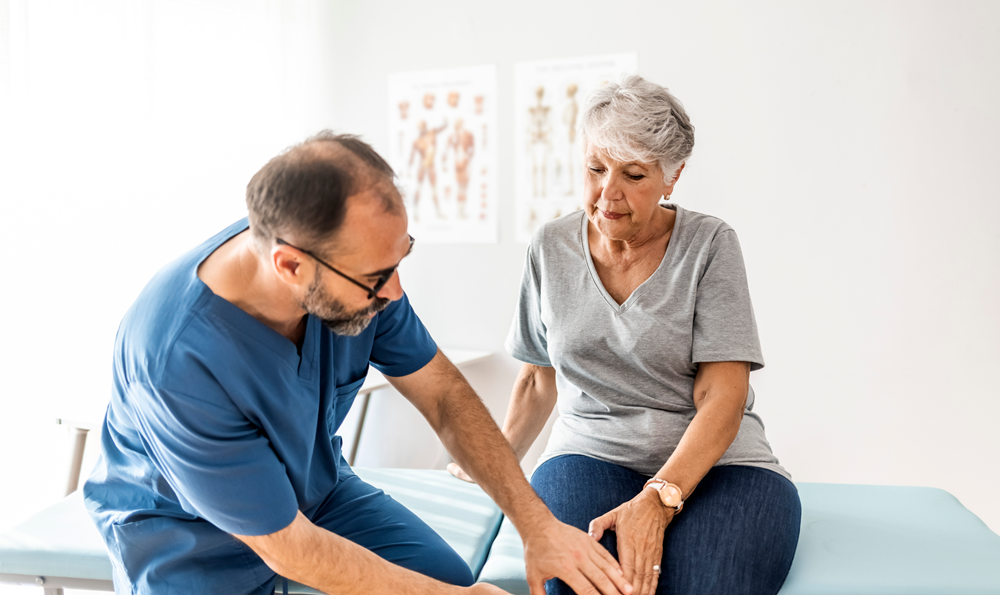Osteoarthritis is the most common form of arthritis, and the World Health Organization estimates that the disease impacts nearly 600 million people around the world. If you’re struggling with painful symptoms of osteoarthritis, we’ve got tips from an expert to help you find the relief you need.
“Osteoarthritis is a very common condition that can cause significant discomfort and pain,” says David Levine, DO, an orthopedic surgeon at Atlantic Health. “Treatments for the condition have come a long way, so we have a lot of options when it comes to helping patients find relief and long-term solutions to resolve their arthritis symptoms.”
What causes osteoarthritis?
Dr. Levine says that he sees osteoarthritis most often in people who are in their 50s, 60s and 70s. The condition results in the loss of cartilage in joints such as your knees and hips. Wear and tear on your joints is a natural part of aging and living an active lifestyle, but an injury can cause the condition to occur in younger patients.
“Osteoarthritis can also have a genetic component, and it tends to run in families,” says Dr. Levine. “Obesity and trauma can also play a big role in the onset of arthritis.”
While there is no way to reverse osteoarthritis, some healthy lifestyle choices that can help slow down the disease’s progression include:
- Exercising regularly to keep your joints healthy and build muscle mass
- Maintaining a healthy weight through physical activity and a Mediterranean-style diet
- Reducing inflammation by working with your physician to manage auto-immune disorders, diabetes or other chronic health conditions
Signs and symptoms of osteoarthritis
Osteoarthritis generally has three stages: mild, moderate and severe. Dr. Levine explains that in addition to a physical exam to evaluate your joints, imaging such as an X-ray of your knee or hip is needed to diagnose and stage your condition.
The most prominent symptom of osteoarthritis is joint pain. Other indicators that you might have arthritis include the following:
- Swelling in your joint(s)
- Loss of motion in the affected joint(s)
- Joint stiffness after sitting
- Pain with increased activity
- A decrease in how far or how fast you can walk
Dr. Levine says it’s time to see your provider if you have pain for more than two weeks or difficulty with daily living activities such as getting around in your home safely, dressing yourself or completing essential errands.
“If you find that you have prolonged periods of pain in your joints that keep you from activities you typically enjoy, it’s time to get it checked out,” says Dr. Levine. “So many people put off going to the grocery store or have a lot of trouble getting their shoes on, but you don’t have to live with that kind of discomfort or those limitations.”
However, arthritis is just one of many conditions that can cause joint pain and swelling. So if you’ve had a fall or other injury, Dr. Levine stresses that it’s important to see a medical provider right away to rule out a sprain or other ligament injury, infection or fracture.
Treatments for osteoarthritis
As an osteopathic physician, Dr. Levine believes in trying conservative, low-risk treatments before recommending surgery. Some initial methods to reduce or control your osteoarthritis symptoms might include:
- Activity modification
- Using an assistive device, such as a cane or a brace to support your joint
- Physical therapy
- Exercise program designed to strengthen your joints and the surrounding muscles
- Anti-inflammatory medications
- Steroid injections
When less-invasive treatments fail or don’t resolve your pain and mobility concerns, it might be time for joint replacement surgery. The procedure has come a long way, and now the surgery is performed using smaller incisions during robot-assisted procedures that provide greater precision than ever before. Dr. Levine says that patients are up, walking and often go home the same day they have surgery.
“Unfortunately, we can’t put cartilage back into your knee or hip, but we do have a lot of options that can help you feel better,” says Dr. Levine. “Surgery isn’t the only way and there are plenty of conservative treatments than can help provide the relief that you are looking for.”












